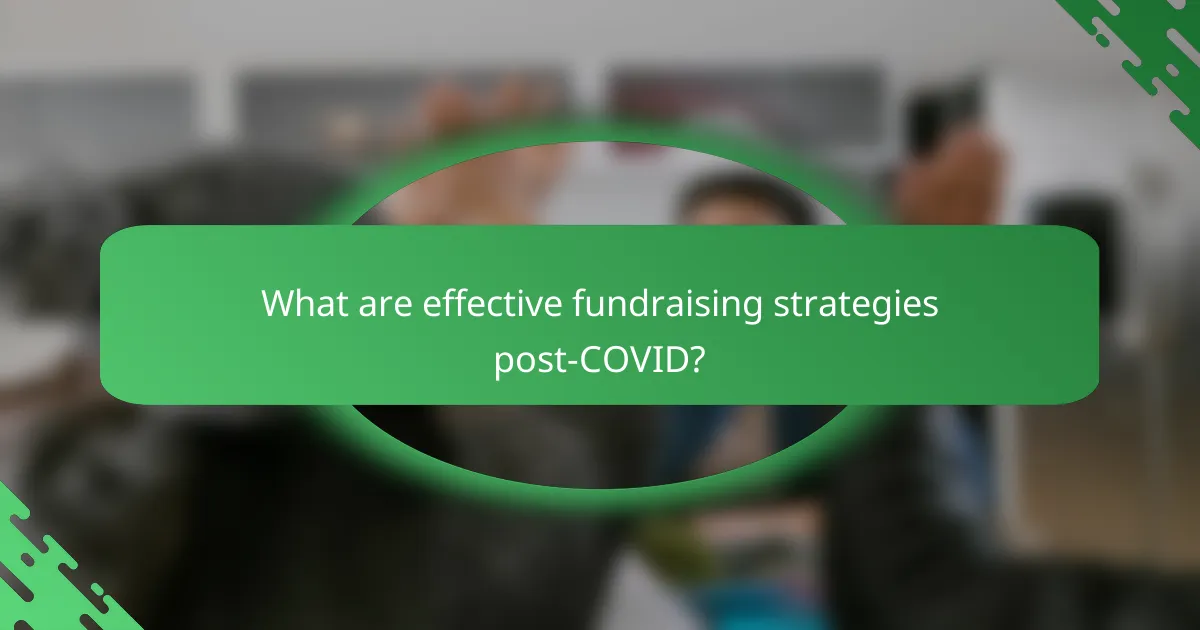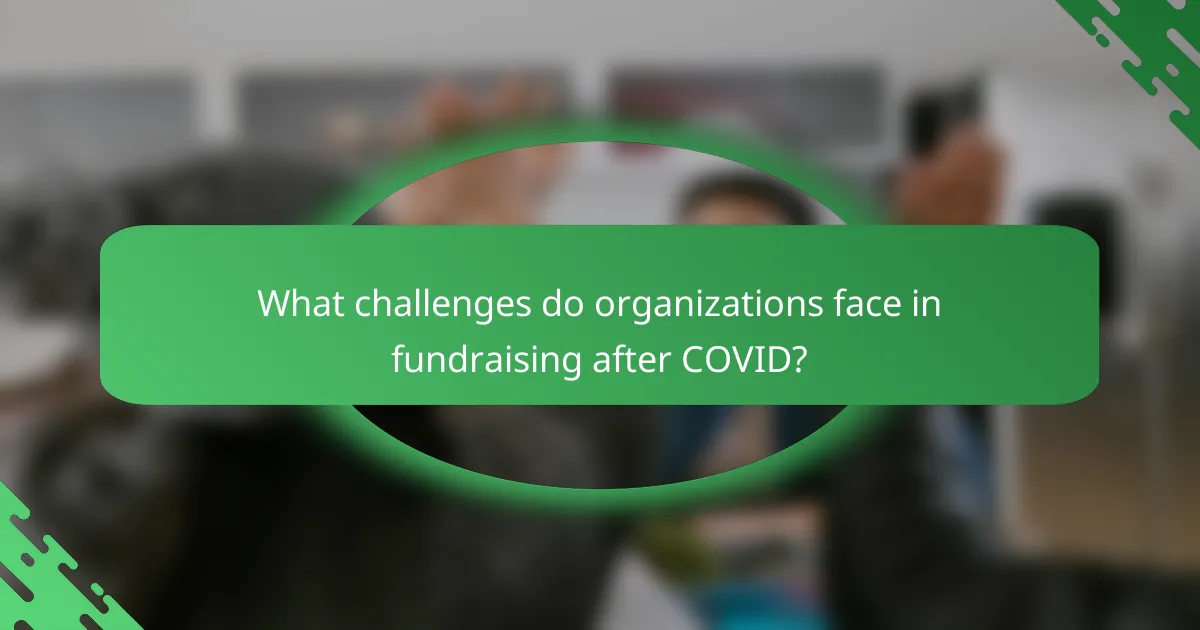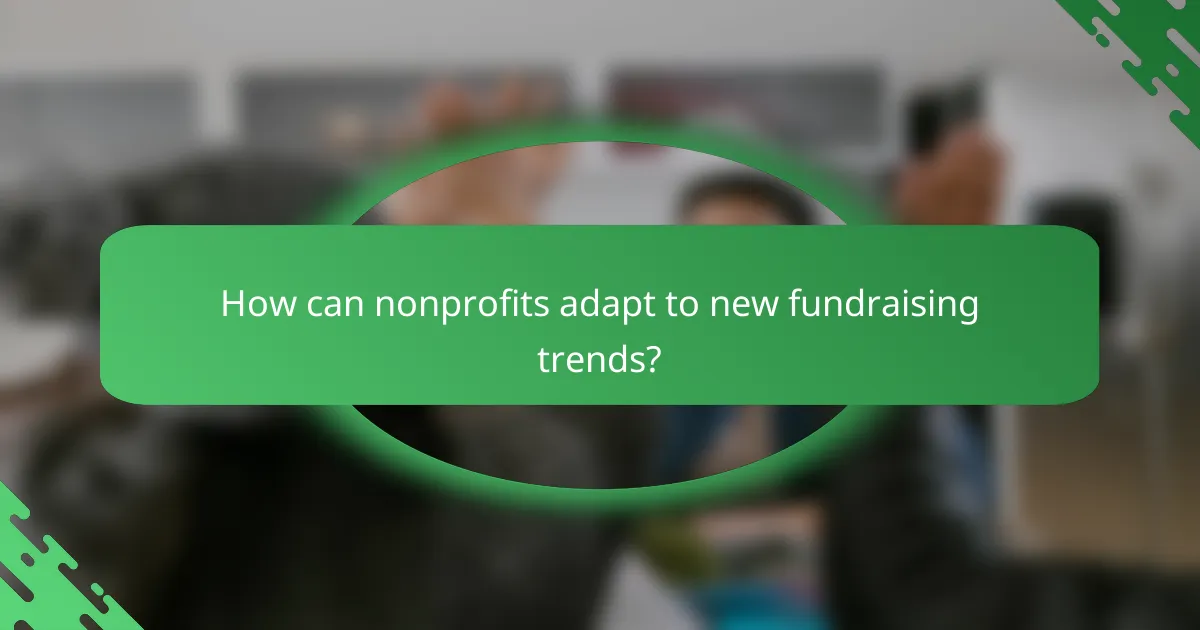In the wake of COVID-19, fundraising strategies have evolved significantly, emphasizing the need for organizations to leverage technology and adapt to shifting donor preferences. While challenges such as donor fatigue and economic uncertainty persist, nonprofits can thrive by embracing innovative approaches, enhancing digital engagement, and fostering strong partnerships. By personalizing communication and utilizing data analytics, organizations can effectively navigate the new fundraising landscape and connect with supporters in meaningful ways.

What are effective fundraising strategies post-COVID?
Effective fundraising strategies post-COVID leverage technology and adapt to changing donor preferences. Organizations must focus on digital engagement, innovative event formats, and building strong partnerships to maximize their fundraising potential.
Digital fundraising campaigns
Digital fundraising campaigns have become essential for reaching donors remotely. Utilizing platforms like crowdfunding sites, email campaigns, and social media can help organizations connect with a broader audience. Consider creating compelling narratives and visuals to engage potential donors effectively.
To optimize these campaigns, set clear goals, track performance metrics, and adjust strategies based on donor feedback. Offering incentives, such as matching donations or exclusive content, can also enhance participation and contributions.
Hybrid events
Hybrid events combine in-person and virtual elements, allowing organizations to reach diverse audiences. This format accommodates those who prefer attending physically while engaging remote participants through live streaming and interactive features. Planning should include technology setups that ensure seamless participation for both groups.
When organizing hybrid events, consider ticket pricing strategies that reflect the value of both experiences. Offering tiered pricing can cater to different donor capabilities and encourage higher contributions from those attending in person.
Corporate partnerships
Building corporate partnerships can significantly enhance fundraising efforts. Collaborating with businesses can provide access to new donor networks and resources, such as matching gifts or sponsorship opportunities. Approach potential partners with clear value propositions that align with their corporate social responsibility goals.
To establish successful partnerships, maintain open communication and align your mission with the partner’s objectives. Regular updates and recognition can strengthen these relationships and encourage ongoing support.
Recurring donation models
Recurring donation models offer a reliable revenue stream by encouraging donors to contribute regularly, such as monthly or quarterly. This approach fosters donor loyalty and allows organizations to plan budgets more effectively. Highlight the impact of sustained support in your messaging to motivate donors.
Implementing easy-to-use donation platforms and providing options for customization can enhance the donor experience. Consider offering benefits, such as exclusive updates or recognition, to incentivize recurring contributions.
Social media engagement
Social media engagement is crucial for building community and driving fundraising efforts. Platforms like Facebook, Instagram, and Twitter allow organizations to share stories, updates, and fundraising campaigns with a wide audience. Regularly posting engaging content can keep your mission top-of-mind for potential donors.
Utilize social media tools to track engagement metrics and adjust your strategies accordingly. Encourage followers to share your content and participate in campaigns, creating a sense of community and increasing visibility for your fundraising initiatives.

What challenges do organizations face in fundraising after COVID?
Organizations face several significant challenges in fundraising after COVID, including donor fatigue, increased competition, economic uncertainty, and shifts in donor priorities. These factors complicate the fundraising landscape, requiring organizations to adapt their strategies to remain effective.
Donor fatigue
Donor fatigue occurs when individuals become overwhelmed by constant requests for support, leading to decreased engagement and contributions. After the pandemic, many donors have been approached repeatedly by various organizations, which can result in a reluctance to give.
To combat donor fatigue, organizations should focus on building meaningful relationships with their supporters. Personalizing communication and showing the impact of donations can help re-engage donors and encourage continued support.
Increased competition
The fundraising landscape has become more competitive as many organizations seek to recover from the financial impacts of COVID. Nonprofits, charities, and community groups are all vying for the same pool of donor resources, making it essential to stand out.
To navigate this increased competition, organizations should clearly articulate their unique value propositions and the specific needs they address. Highlighting success stories and demonstrating transparency can differentiate an organization from others in the field.
Economic uncertainty
Economic uncertainty continues to affect donor behavior, as individuals and businesses may be hesitant to commit funds during fluctuating financial conditions. This uncertainty can lead to reduced giving, particularly for larger donations.
Organizations should consider diversifying their funding sources to mitigate the impact of economic fluctuations. Exploring grants, corporate partnerships, and innovative fundraising methods can provide more stability in uncertain times.
Shifts in donor priorities
Donor priorities have shifted significantly post-COVID, with many individuals focusing on immediate community needs and social justice issues. This change can affect traditional fundraising strategies that may no longer resonate with potential donors.
Organizations should conduct regular assessments of donor interests and adapt their messaging accordingly. Engaging donors in conversations about their priorities and aligning fundraising efforts with those interests can foster stronger connections and support.

How can nonprofits adapt to new fundraising trends?
Nonprofits can adapt to new fundraising trends by embracing technology, personalizing communication with donors, and utilizing data analytics. These strategies help organizations remain relevant and effectively engage with their supporters in a rapidly changing environment.
Leveraging technology
Technology plays a crucial role in modern fundraising. Nonprofits can use online platforms for crowdfunding, virtual events, and peer-to-peer fundraising, which have gained popularity post-COVID. For example, hosting a virtual gala can reach a wider audience without geographical limitations.
Additionally, implementing mobile giving options allows donors to contribute easily through their smartphones. Nonprofits should ensure their websites are optimized for mobile use and consider using apps that facilitate donations.
Personalizing donor communication
Personalized communication enhances donor engagement and retention. Nonprofits should segment their donor base and tailor messages based on individual preferences and past contributions. For instance, sending targeted emails that acknowledge previous donations can foster a stronger connection.
Utilizing tools like CRM systems can help track donor interactions and preferences, allowing organizations to craft more meaningful outreach. Regular updates about the impact of donations can also reinforce the relationship between the nonprofit and its supporters.
Utilizing data analytics
Data analytics enables nonprofits to make informed decisions about their fundraising strategies. By analyzing donor behavior and trends, organizations can identify which campaigns are most effective and where to allocate resources. For example, tracking donation patterns can reveal peak giving times or preferred donation amounts.
Nonprofits should invest in analytics tools that provide insights into donor demographics and engagement levels. This information can guide future fundraising efforts and help refine messaging to resonate with specific audiences.

What role do corporate partnerships play in post-COVID fundraising?
Corporate partnerships are essential in post-COVID fundraising as they provide nonprofits with access to resources, networks, and expertise that can enhance their fundraising efforts. These collaborations can lead to innovative strategies that leverage both parties’ strengths to achieve mutual goals.
Access to new donor networks
Corporate partners often have established relationships with a diverse range of donors, including individuals, foundations, and other businesses. By collaborating with these companies, nonprofits can tap into these networks, expanding their reach and increasing their donor base.
For example, a nonprofit focused on environmental conservation might partner with a corporation in the renewable energy sector. This partnership could introduce the nonprofit to environmentally conscious donors who are already engaged with the corporation.
Shared marketing initiatives
Joint marketing campaigns can amplify the visibility of both the nonprofit and the corporate partner. By pooling resources, organizations can create more impactful marketing materials that resonate with a wider audience.
Consider a campaign where a nonprofit and a corporation co-host an event. This event can attract attendees from both organizations, allowing for cross-promotion and increased engagement. Utilizing social media platforms to promote the event can further enhance outreach.
Increased credibility
Partnering with a well-respected corporation can enhance a nonprofit’s credibility in the eyes of potential donors. When a company with a strong reputation supports a nonprofit, it signals to donors that the organization is trustworthy and effective.
For instance, if a nonprofit focused on education collaborates with a well-known tech company, it can leverage that partnership to build trust with donors who value innovation and quality in educational initiatives. This credibility can lead to increased donations and support for the nonprofit’s mission.

How can organizations measure fundraising success?
Organizations can measure fundraising success through various metrics that reflect their financial health and donor engagement. Key indicators include total funds raised, donor retention rates, and the effectiveness of fundraising campaigns.
Key performance indicators (KPIs)
Key performance indicators (KPIs) are essential metrics that help organizations assess their fundraising efforts. Common KPIs include total donations received, average donation size, and the number of new donors acquired within a specific timeframe.
To effectively track KPIs, organizations should establish clear goals and regularly review their performance against these benchmarks. For example, a nonprofit might aim to increase its total donations by 15% over the next year, using monthly reports to monitor progress.
Donor retention rates
Donor retention rates measure the percentage of donors who continue to contribute to an organization over time. High retention rates indicate that donors are satisfied and engaged, which is crucial for sustainable fundraising.
To improve donor retention, organizations can implement strategies such as personalized communication, regular updates on the impact of donations, and appreciation events. For instance, sending thank-you notes or hosting donor recognition events can foster loyalty and encourage repeat giving.
